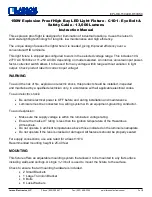
RTC
®
5 PC Interface Board
Rev. 1.9 e
7 Basic Functions for Scan Head and Laser Control
144
innovators for industry
During initialization of the RTC
®
5 (with
), the scaling function
Scale
(
Position
)
= 1.0
will be loaded for the full
position range, with the effect that no position-
dependent correction will be executed.
Notes on Loading and Determining Nonlinearity
Curves
The command
loads a
table for the nonlinearity curve
Scale
(
Percent
) from
an ASCII text file. The text file can contain one or more
tables.
Each table can contain up to 50 data points
(
Percent
Scale
(
Percent
)) for various percent values.
The RTC
®
5 determines the nonlinearity curve
Scale
(
Percent
) from this data by linear interpolation.
For the table, the following rules apply:
• Each table must start with the instruction
(Caption)
[
AutoLaserCtrlTable
<No>]
where
<No>
must be replaced by a nonnegative
integer which denotes the table number.
• If the table contains multiple
[AutoLaserCtrlTable<No>]
entries with the same
<No>
, then only the instructions after the first
entry will be used; instructions that follow further
entries will be ignored. Only instructions up to the
next ’[’ character (that is not preceded by a
semicolon) are used.
• Each data point (
Percent
|
Scale
(
Percent
)) is
described by two instructions:
Percent<n> = <Value>
Scale<n> = <Value>
where
<n>
must be replaced by an integer
(1
<n>
50) which denotes the number of the
data point. The values
<Value>
can be specified as
(unsigned) floating point numbers. Use the
period
(.)
as the decimal separator.
• If the table contains multiple data points with the
same Index
<n>
, then the most recently read one
will be used and the previous ones ignored.
• If the table contains multiple data points with the
same percent value
Percent
, then the data point
with the largest Index
<n>
will be used and the
others ignored. Equality is checked to within
±0.01°.
• The percent value refers to the 100% value (that
can additionally be further changed through
vector-defined laser control, see
) set via
(
Value
parameter).
In the following example, a nonlinearity factor of
1.2 is set for a 1.5x multiple of the 100% value:
Percent<n> = 150
Scale<n> = 1.2
• For
<Value>
, the following ranges apply
0.0
Percent
400.0 and
0.0
Scale
(
Percent
)
4.0.
• Each instruction must be in a separate line.
• Spaces and tabs in a line (e.g. between ’
=
’ and
<Value>
) are ignored.
• Empty lines are ignored.
• Data points with invalid values are ignored.
• The data point of a particular index
<n>
is ignored
if the corresponding
Percent<n>
and/or
Scale<n>
definition is missing.
• The semicolon ’;’ can be used for comments. All
characters in a line following a semicolon are
ignored.
• The instructions for data points in the table can
be ordered as desired.
• Indices for data point pairs in the table can be
selected as desired within the range [1…50] (the
table will then be automatically sorted by
ascending percent values).
• If the table contains
no
valid data point, then the
command
effect (return value 1 or 13).
• If there is no entry for
Percent
= 0.0, then an
entry with
Scale
= Min(
Scale<i>
) will be
inserted (the smallest allowed value defined in
the table will be used for lower percent values).
Likewise for
Percent
= 400.0 with
Max(
Scale<i>
).
During initialization of the RTC
®
5 (with
), the function
Scale
(
Percent
)
= 1.0
will be loaded for the full
percent range (no nonlinearity). Alternatively, this
can also be achieved with
Name
= 0 in
.
















































